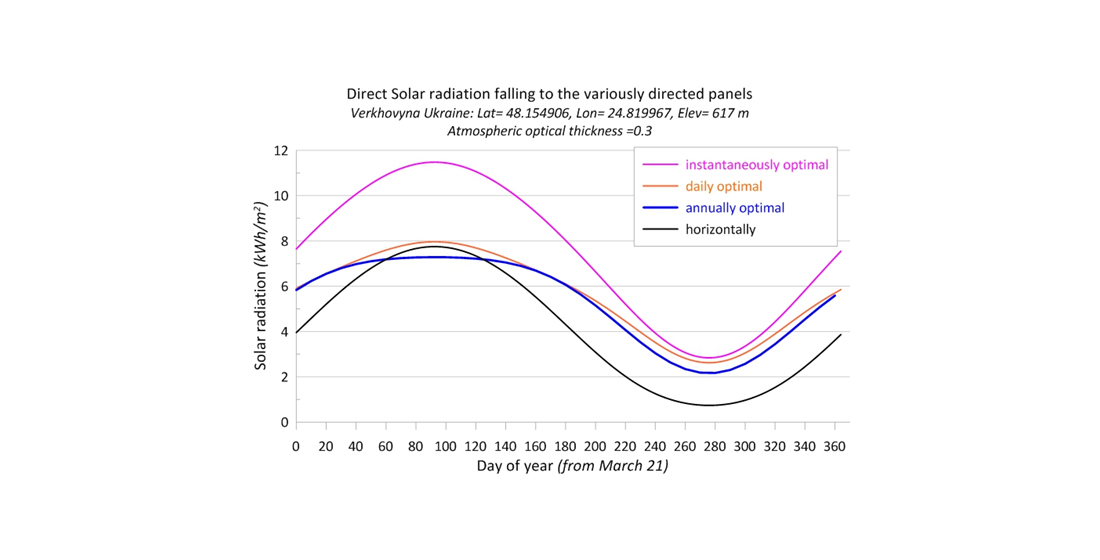Development of software for calculation of optimal direction of solar panels during «time of use» in regions with complex topography
DOI:
https://doi.org/10.15587/2706-5448.2022.271440Keywords:
solar panel, optimal direction, relief function, optical thicknesses, cloudiness, softwareAbstract
The object of current research is efficient usage of solar energy via optimal panel orientation. Using the mathematical methods of finding extremal value of function, the software was developed to calculate the daily optimal direction of PV panel. The knowledge of daily optimal direction of PV panels enables to determine the optimal panel direction for any time of use which allows maximizing the amount of harvested solar energy. The proper functioning of this software has been confirmed by field measurements. It was found that panel optimal direction can be determined by considering only the direct solar radiation, since taking into account diffuse solar radiation of sky practically doesn’t affect optimal PV panel direction. The essential factors affecting the optimal direction of PV panel are the topography of the considered site and the significant changes of optical thickness, for example, before and after noon. The calculations also show that the partial cloudiness doesn’t remarkably affect the optimal PV panel direction, but the regular presence of clouds in same part of the sky does affect it. This software is applied to the Ukrainian site Verkhovyna for which the optimal daily, seasonal and annual solar panel directions are calculated and presented. The formula to calculate the optimal direction for any time of use via daily optimal tilt angle and daily direct solar radiation falling onto the panel is given. The interface of the software has been designed in a user-friendly way and can be easily used by wide range of consumers. This software will especially be useful for quick calculation of optimal direction of solar panels in tourist sites located in mountainous regions.
Supporting Agency
- Presentation of research in the form of publication through financial support in the form of a grant from SUES (Support to Ukrainian Editorial Staff).
References
- World Energy Outlook 2022 (2022). Available at: https://www.iea.org/reports/world-energy-outlook-2022
- Wong, L. T., Chow, W. K. (2001). Solar radiation model. Applied Energy, 69 (3), 191–224. doi: https://doi.org/10.1016/s0306-2619(01)00012-5
- Rigollier, C., Bauer, O., Wald, L. (2000). On the clear sky model of the ESRA – European Solar Radiation Atlas – with respect to the heliosat method. Solar Energy, 68 (1), 33–48. doi: https://doi.org/10.1016/s0038-092x(99)00055-9
- Ruiz-Arias, J. A., Pozo-Vázquez, D., Lara-Fanego, V., Santos-Alamillos, F. J., Tovar-Pescador, J. (2011). A High-Resolution Topographic Correction Method for Clear-Sky Solar Irradiance Derived with a Numerical Weather Prediction Model. Journal of Applied Meteorology and Climatology, 50 (12), 2460–2472. doi: https://doi.org/10.1175/2011jamc2571.1
- Ahmad, M. J., Tiwari, G. N. (2011). Solar radiation models-A review. International Journal of Energy Research, 35 (4), 271–290. doi: https://doi.org/10.1002/er.1690
- Katiyar, A. K., Pandey, C. K. (2013). A Review of Solar Radiation Models – Part I. Journal of Renewable Energy, 2013, 1–11. doi: https://doi.org/10.1155/2013/168048
- Antonanzas-Torres, F., Urraca, R., Polo, J., Perpiñán-Lamigueiro, O., Escobar, R. (2019). Clear sky solar irradiance models: A review of seventy models. Renewable and Sustainable Energy Reviews, 107, 374–387. doi: https://doi.org/10.1016/j.rser.2019.02.032
- Gardashov, R., Eminov, M., Kara, G., Emecen Kara, E. G., Mammadov, T., Huseynova, X. (2020). The optimum daily direction of solar panels in the highlands, derived by an analytical method. Renewable and Sustainable Energy Reviews, 120, 109668. doi: https://doi.org/10.1016/j.rser.2019.109668
- Emecen, E. G., Kara, G., Erdogmus, F., Gardashov, R. (2006). The Determination of Sunglint Locations on the Ocean Surface by Observation from Geostationary Satellites. Terrestrial, Atmospheric and Oceanic Sciences, 17 (1), 253–261. doi: https://doi.org/10.3319/tao.2006.17.1.253(aa)
- Gardashov, R. H., Eminov, M. Sh. (2015). Determination of sunglint location and its characteristics on observation from a METEOSAT 9 satellite. International Journal of Remote Sensing, 36 (10), 2584–2598. doi: https://doi.org/10.1080/01431161.2015.1042119
- Global Solar Atlas. Available at: https://globalsolaratlas.info

Downloads
Published
How to Cite
Issue
Section
License
Copyright (c) 2022 Emin Gardashov

This work is licensed under a Creative Commons Attribution 4.0 International License.
The consolidation and conditions for the transfer of copyright (identification of authorship) is carried out in the License Agreement. In particular, the authors reserve the right to the authorship of their manuscript and transfer the first publication of this work to the journal under the terms of the Creative Commons CC BY license. At the same time, they have the right to conclude on their own additional agreements concerning the non-exclusive distribution of the work in the form in which it was published by this journal, but provided that the link to the first publication of the article in this journal is preserved.








